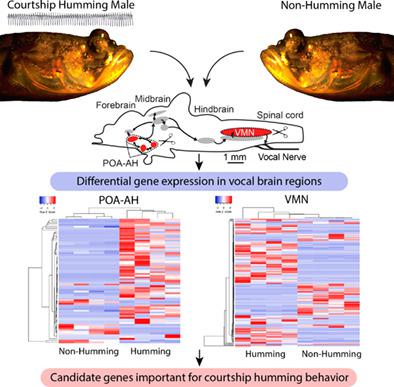当前位置:
X-MOL 学术
›
Genes Brain Behav.
›
论文详情
Our official English website, www.x-mol.net, welcomes your
feedback! (Note: you will need to create a separate account there.)
To hum or not to hum: Neural transcriptome signature of male courtship vocalization in a teleost fish
Genes, Brain and Behavior ( IF 2.4 ) Pub Date : 2021-05-07 , DOI: 10.1111/gbb.12740 Joel A Tripp 1, 2 , Ni Y Feng 1, 3 , Andrew H Bass 1
Genes, Brain and Behavior ( IF 2.4 ) Pub Date : 2021-05-07 , DOI: 10.1111/gbb.12740 Joel A Tripp 1, 2 , Ni Y Feng 1, 3 , Andrew H Bass 1
Affiliation

|
For many animal species, vocal communication is a critical social behavior and often a necessary component of reproductive success. Additionally, vocalizations are often demanding motor acts. Wanting to know whether a specific molecular toolkit might be required for vocalization, we used RNA-sequencing to investigate neural gene expression underlying the performance of an extreme vocal behavior, the courtship hum of the plainfin midshipman fish (Porichthys notatus). Single hums can last up to 2 h and may be repeated throughout an evening of courtship activity. We asked whether vocal behavioral states are associated with specific gene expression signatures in key brain regions that regulate vocalization by comparing transcript expression levels in humming versus non-humming males. We find that the circadian-related genes period3 and Clock are significantly upregulated in the vocal motor nucleus and preoptic area-anterior hypothalamus, respectively, in humming compared with non-humming males, indicating that internal circadian clocks may differ between these divergent behavioral states. In addition, we identify suites of differentially expressed genes related to synaptic transmission, ion channels and transport, neuropeptide and hormone signaling, and metabolism and antioxidant activity that together may support the neural and energetic demands of humming behavior. Comparisons of transcript expression across regions stress regional differences in brain gene expression, while also showing coordinated gene regulation in the vocal motor circuit in preparation for courtship behavior. These results underscore the role of differential gene expression in shifts between behavioral states, in this case neuroendocrine, motor and circadian control of courtship vocalization.
中文翻译:

哼或不哼:硬骨鱼雄性求偶发声的神经转录组特征
对于许多动物物种来说,声音交流是一种重要的社会行为,并且通常是繁殖成功的必要组成部分。此外,发声通常需要运动动作。为了了解发声是否需要特定的分子工具包,我们使用 RNA 测序来研究极端发声行为(平鳍见习官鱼( Porichthys notatus )的求爱嗡嗡声)表现背后的神经基因表达。单次嗡嗡声可持续长达 2 小时,并且可能在整个求爱活动的整个晚上重复。我们通过比较哼唱与不哼唱的男性的转录表达水平,询问声音行为状态是否与调节发声的关键大脑区域的特定基因表达特征相关。我们发现,与不哼唱的男性相比,在哼唱时,发声运动核和视前区下丘脑前部的昼夜节律相关基因period3和Clock分别显着上调,这表明内部生物钟在这些不同的行为状态之间可能有所不同。此外,我们还确定了与突触传递、离子通道和运输、神经肽和激素信号传导、代谢和抗氧化活性相关的一组差异表达基因,这些基因共同可以支持嗡嗡声行为的神经和能量需求。跨区域转录表达的比较强调了大脑基因表达的区域差异,同时也显示了为求爱行为做准备的发声运动回路中的协调基因调节。 这些结果强调了差异基因表达在行为状态之间转变中的作用,在本例中是求偶发声的神经内分泌、运动和昼夜节律控制。
更新日期:2021-07-07
中文翻译:

哼或不哼:硬骨鱼雄性求偶发声的神经转录组特征
对于许多动物物种来说,声音交流是一种重要的社会行为,并且通常是繁殖成功的必要组成部分。此外,发声通常需要运动动作。为了了解发声是否需要特定的分子工具包,我们使用 RNA 测序来研究极端发声行为(平鳍见习官鱼( Porichthys notatus )的求爱嗡嗡声)表现背后的神经基因表达。单次嗡嗡声可持续长达 2 小时,并且可能在整个求爱活动的整个晚上重复。我们通过比较哼唱与不哼唱的男性的转录表达水平,询问声音行为状态是否与调节发声的关键大脑区域的特定基因表达特征相关。我们发现,与不哼唱的男性相比,在哼唱时,发声运动核和视前区下丘脑前部的昼夜节律相关基因period3和Clock分别显着上调,这表明内部生物钟在这些不同的行为状态之间可能有所不同。此外,我们还确定了与突触传递、离子通道和运输、神经肽和激素信号传导、代谢和抗氧化活性相关的一组差异表达基因,这些基因共同可以支持嗡嗡声行为的神经和能量需求。跨区域转录表达的比较强调了大脑基因表达的区域差异,同时也显示了为求爱行为做准备的发声运动回路中的协调基因调节。 这些结果强调了差异基因表达在行为状态之间转变中的作用,在本例中是求偶发声的神经内分泌、运动和昼夜节律控制。











































 京公网安备 11010802027423号
京公网安备 11010802027423号